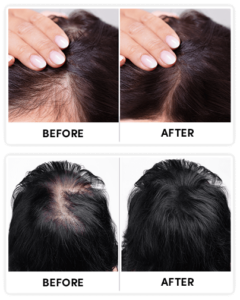The Ultimate Guide to PRP Treatment for Hair: Costs, Benefits, and Long-Term Results

Discovering PRP Hair Treatment: A Natural Way to Regain Your Locks
Is your thinning hair or receding hairline causing you distress? You're definitely not alone. There's a trending solution you might want to check out: PRP treatment for hair. This cutting-edge therapy is all about rejuvenating your hair naturally. But what exactly is PRP, and how does it work its wonders on your hair? Let's dive into this guide that covers everything about PRP treatment for hair, including costs, benefits, and what you can expect in the long run. By the end, you'll have a clear idea if this treatment is right up your alley.
Decoding PRP Treatment
PRP stands for Platelet-Rich Plasma, a treatment that uses your own blood. Essentially, PRP is a concentrated collection of platelets packed with growth factors. These growth factors are crucial for healing and regenerating cells. When it comes to hair restoration, PRP involves injecting this concentrated plasma into your scalp, aiming to wake up those hair follicles and spark natural hair growth.
How PRP Works Its Magic for Hair Growth
The procedure is surprisingly simple, yet scientifically intriguing. It starts with drawing a small sample of your blood, which is spun in a centrifuge to separate the platelet-rich plasma from other blood components. This PRP is then injected into specific areas of your scalp. The growth factors in the plasma help rejuvenate and repair hair follicles, promoting thicker, healthier hair.
The Science Behind PRP Therapy
The science backing PRP therapy is quite compelling. Growth factors in platelets are well-known for their role in healing and regeneration. For hair restoration, these growth factors are thought to extend the growth phase of hair and improve follicular health, leading to better hair density and coverage. While research is ongoing, many see promising results, especially when other methods fall short.
The Financial Side of PRP Hair Treatment
Let's chat about the money aspect. If you're considering PRP, one of your main concerns is likely the cost. So, what should you expect to shell out for PRP hair treatment?
Typical PRP Treatment Costs
The price of PRP hair treatment can vary widely depending on several factors. On average, expect to pay anywhere from $500 to $2,500 per session. Keep in mind that multiple sessions are often necessary for the best results, so it's smart to consider the total cost when planning your budget.
What Affects PRP Treatment Pricing
Several factors can influence the overall cost of PRP treatments. These include the clinic's location, the practitioner's expertise, and their specific treatment protocol. Some clinics might offer package deals or payment plans to help manage the costs.
Comparing PRP Costs with Other Hair Restoration Methods
When weighing the cost-effectiveness of PRP, it's helpful to compare it to other hair restoration methods. Hair transplants, for example, can be much pricier and involve more invasive procedures. Topical treatments might be cheaper upfront, but they often require ongoing use and can have mixed results. PRP strikes a balance between cost and invasiveness, offering a sweet spot for many in terms of affordability and effectiveness.
Top Trichologist: Do This To Your Scalp To Regrow A Full Head Of Hair

Completely natural and dirt cheap way that makes it possible for you to finally regrow all your hair back.
Try this at homeExploring the Perks of PRP Hair Treatment
Beyond the cost, it's the benefits of PRP that truly grab attention. Let's explore why PRP is such an appealing option for those looking to restore their hair.
Kickstarting Natural Hair Growth
A major draw of PRP treatment is its ability to stimulate natural hair growth. By utilizing platelets from your blood, the treatment boosts hair follicle health without synthetic chemicals or invasive surgeries. This natural approach is particularly appealing for those seeking a holistic treatment.
Boosting Hair Density and Thickness
PRP doesn't just encourage hair growth; it can also enhance the density and thickness of the hair you already have. Many patients notice improvements in hair texture and volume after completing several PRP sessions, resulting in a fuller and more youthful look.
Low-Risk, Non-Invasive Procedure
If you're concerned about side effects, PRP has a reassuringly low-risk profile. Since the treatment uses your own biological material, the chance of adverse reactions is minimal. Plus, the procedure is non-invasive, meaning there's little to no downtime, so you can get back to your daily activities almost right away.
A Closer Look at the PRP Treatment Process
Curious about what happens when you opt for PRP treatment? Let’s break down the process from start to finish, so you'll know exactly what to expect.
Your First Consultation
Your PRP journey begins with a detailed consultation with a qualified practitioner. During this meeting, they'll review your medical history and assess your scalp. It's the perfect time to discuss your goals and ask any questions you have about the treatment.
Step-by-Step PRP Procedure
Once you're ready, the PRP procedure itself is pretty straightforward. First, a small amount of blood is drawn from your arm. This sample is then placed in a centrifuge to separate the platelet-rich plasma. Once the PRP is ready, it's injected into your scalp with fine needles, targeting areas that need the most attention. The whole process usually takes about an hour.
After Treatment: Care and Recovery
Post-treatment care is simple. You might feel some mild discomfort or notice slight swelling at the injection sites, but these symptoms typically fade quickly. Most people can go back to their daily routines immediately, though it's wise to follow any specific aftercare instructions from your practitioner to maximize the results.
Watch Your Hair Come Back FASTER Than You EVER Dreamed Possible

WITHOUT Expensive Medications, Lasers, or Painful Surgeries!
Watch nowLong-Term PRP Hair Treatment Results
While the procedure itself is essential, it’s the long-term results that most folks are interested in. What might you expect from PRP treatment in the months and years ahead?
When to Expect Visible Results
The timeline for seeing results can vary, but most people start noticing improvements within three to six months of beginning treatment. Hair growth is gradual, with density and thickness improving over time. Patience is key as the regenerative process unfolds naturally.
The Longevity of PRP Results
One of the great things about PRP treatment is its lasting impact. Many enjoy enhanced hair growth benefits for a year or more after the initial series of treatments. However, maintenance sessions are often recommended to sustain and boost results over time.
Keeping Your Results Fresh
To keep your new hair growth thriving, regular touch-up sessions might be necessary. The frequency of these sessions depends on individual responses and goals, but typically, maintenance treatments are scheduled every six to twelve months.
Who Can Benefit from PRP Hair Treatment?
PRP therapy isn't for everyone, so how do you know if it’s a good match? Let's explore who stands to gain the most from this treatment.
Who Makes an Ideal PRP Candidate?
Typically, individuals in the early stages of hair thinning or those with mild to moderate hair loss are considered ideal candidates. PRP is particularly effective for those whose hair follicles are still active but need a little help to regain lost density.
Conditions PRP Can Address
PRP is a versatile treatment that can address various conditions like androgenetic alopecia (pattern baldness), stress-induced hair thinning, and even hair loss after medical treatments. It's a flexible option that can complement other hair restoration therapies.
When PRP Might Not Be the Best Fit
PRP may not suit everyone. Those with severe hair loss or inactive hair follicles might not see the results they hope for. Additionally, individuals with certain medical conditions or on specific medications should consult a healthcare professional to determine if PRP is a safe option for them.
Why The Ancient Samurai Warriors Never Lost Their Hair…

guaranteed to work for any men or women out there...
Try this at homePRP vs. Other Hair Restoration Options
When exploring hair restoration, it's good to compare PRP with other available options to make a well-informed decision.
PRP vs. Hair Transplants
Hair transplants involve surgically moving hair follicles from one part of the body to another. While highly effective, it's invasive and can be costly. On the flip side, PRP is non-surgical, less expensive, and offers a quicker recovery, making it an appealing alternative for those seeking less intensive interventions.
PRP vs. Topical Treatments
Topical treatments like minoxidil are common for hair restoration, but they require daily application and can sometimes have side effects. PRP, however, involves fewer applications (usually monthly sessions) and uses your body's healing mechanisms, which can be attractive for those wanting a more natural approach.
Pros and Cons of PRP Compared with Other Methods
When weighing PRP against other treatments, consider both the pros and cons. PRP is minimally invasive, relies on natural processes, and has little downtime, but results can vary and require ongoing maintenance. Other methods, like hair transplants, offer permanent solutions but come with higher costs and greater risks.
Final Thoughts on PRP Hair Treatment
To sum it all up, PRP treatment for hair offers a unique mix of natural growth stimulation, minimal side effects, and non-invasive procedures. While it's not a one-size-fits-all solution, it provides a viable option for many looking to rejuvenate their locks.
Recapping PRP Treatment Benefits
From sparking hair growth to boosting density and thickness, PRP has plenty of perks. Its natural approach and low-risk profile make it an appealing choice for those wanting to revitalize their hair without undergoing surgery.
Key Things to Weigh When Choosing PRP Therapy
When considering PRP therapy, it's essential to weigh factors like cost, expected results, and maintenance needs. Consulting with a healthcare professional can provide valuable insights into whether PRP is the right choice based on your specific circumstances.
Encouragement to Seek Professional Advice
In the end, getting guidance from a healthcare professional is crucial in deciding if PRP treatment aligns with your hair restoration goals. Their expertise can help you make an informed decision, paving the way for a more confident and hairful future.






